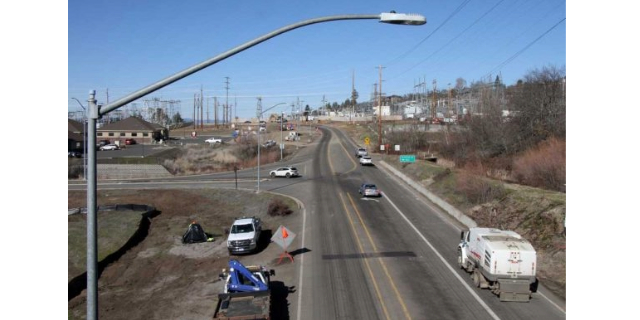Four-decade-old Winter Wings birding festival canceled for 2024
Published 6:00 am Friday, January 5, 2024

- On a 2020 Winter Wings Festival field trip, a group of women enjoy spotting herons and searching for Barrow’s Goldeneyes with local photographer Bill Gogo.
KLAMATH FALLS — Winter Wings, the nation’s oldest birding festival, won’t be taking flight this year.
Trending
The Winter Wings Festival, which began in 1980 as the Bald Eagles Conference, normally takes place during the Presidents’ Day weekend in February in Klamath Falls. The gathering has gained national attention because it has offered field trips, seminars and programs that have attracted birders from around the nation, including contingents and individuals from the Rogue Valley.
Co-directors Anne Wenner and Diana Samuels said the decision to cancel this year’s gathering was made because of multiple factors, including ongoing droughts that have left several areas in the Klamath Basin National Wildlife Refuge complex, including the Tule Lake and the Lower Klamath National Wildfire refuges, without water for extended periods of time.
“The Klamath Basin has been in the grips of a severe drought for multiple years,” Samuels and Wenner said in a statement. “Competing endangered fish species and over-allocation of remaining water resources have left the Tule Lake and LKNW refuges bone dry. Now migratory waterfowl and the raptors that feed on them have bypassed the Basin in search of better habitat.”
Trending
In addition, they noted the Klamath Basin Audubon Society (KBAS), which has organized the Festival, is — like other groups — having trouble adding younger members. In the statement, Wenner and Samuels noted, “We are facing other challenges to continuing with the status quo besides the water situation. First and foremost is the aging demographic of both our attendees and our volunteers, despite concerted efforts to engage a younger crowd.”
They said KBAS is seeking new board members, adding in another statement, “Later in 2024 that group will discuss fundraising options. If you have ideas for what a future festival or venue could look like, or would like to volunteer, please email Anne Wenner at aewenner@gmail.com or Diana Samuels at dsamuels@charter.net.”
“We are very proud of elevating the Winter Wings Festival to one of the top 10 birding festivals in the nation,” Samuels said. “We have brought some of the most elite birders and photographers to Klamath Falls and provided a venue for them to share their passions, expertise, and insights.
“My personal favorite was videographer Gerrit Vyn with the Cornell Lab of Ornithology, who shared a fabulous video at his keynote about the plight of birds in three countries and what was being done to improve their conditions,” Samuels continued. “Another highlight was bringing James Curry out to do a ‘Birding Adventure’ television show on Klamath Basin featuring our local birders and photographers.”
Wenner also expressed thoughts on her years being involved and helping to lead Winter Wings.
“I became involved with the Bald Eagle Conference/WWF shortly after arriving in Klamath Falls in the early ’90s,” she explained. “Being part of this event’s transition from scientific venue to a nationally recognized birding and photography festival and fundraiser for our local Audubon chapter has been a phenomenal and extremely rewarding experience.
“The reason my family and I chose to move to the Klamath Basin was in large part because of its incredible wildlife diversity,” Wenner added. “One purpose of the Winter Wings Festival has been to celebrate and encourage stewardship of the natural diversity of the Basin.
“My years as co-coordinator have made me even more aware of the unique position the Klamath Basin holds for collaborative, creative restoration and the critical importance of this area as a model for other challenged ecosystems. I feel compelled to personally focus on encouraging, facilitating, enacting, and promoting ongoing and future creative habitat restoration efforts,” she added, noting, “This directly parallels the goals and mission of the Klamath Basin Audubon Society that I am proud to be a board member of. There are multiple positive actions in the works including removal of the Klamath dams, wetland restoration on private lands, creative water rights transfers, and more to come or that haven’t even been imagined yet. I have made the decision to step back and play more of a mentorship role in Festival planning as this event transitions once again, but I am transitioning in a positive way as well.
“I would love,” Wenner said, “to share the lessons we have learned with new leaders who would like to step forward to come up with a new birding event for Klamath Falls.”
The Winter Wings Festival, a long-time, much-anticipated event that began in 1980 in Klamath Falls as the Bald Eagle Conference, has an impressive history.
It was originally created to “provide a platform for discussing issues of bald eagle management relative to the habitat, politics, and the economy of the area,” according to Diana Samuels and Anne Wenner, who have served as co-directors the past many years.
When it began, bald eagles, the national bird, were on their way to recovery after being on the federal Endangered Species List. The Klamath Basin was and is known for hosting the largest wintering concentrations of bald eagles in the lower 48 states, with populations of upwards of 500. Peak migration periods are January and February. Bald eagles primarily migrate to the Basin from Canada, with some coming from the Northwest Territories in Canada.
The Bald Eagle Conference event drew professionals, conservationists and members of the public who were anxious to share data and information about this endangered species. Field trips, in addition to workshops and presentations, were an integral part of the conference, and the National Wildlife refuges in the area played a critical role.
In 2005, the conference was renamed the Winter Wings Festival. The change came about because bald eagles had recovered sufficiently enough to be removed from the endangered species list. The change also reflected the region’s massive numbers and variety of other species, including wintering raptors, waterfowl and other birds. Because of the abundant populations and varieties, the Klamath Basin was becoming a well-known attraction to birders throughout the country. The series of Basin refuges hosted upwards of 80% of migrating waterfowl using the Pacific Flyway, with numbers exceeding a million birds.
“The Winter Wings Festival offered a venue for these enthusiasts to gather, experience and learn and expanded its repertoire to include family friendly activities, youth art contests, vendors, and, increasingly, opportunities for nature photographers as well,” Wenner and Daniels explained of the name change. “Sponsors as diverse as the U.S. Fish and Wildlife Service, Pacific Power, Discover Klamath, Oregon Institute of Technology, Sky Lakes Medical Center, realtors, insurance companies, etc. supported the festival and a cadre of volunteers spent countless hours and even months planning and participating each year.”
They also note the festival is the primary fundraiser for the Klamath Basin Audubon Society, with proceeds used to support local grants to teachers and other entities for outdoor education and community nature-related projects.
“The rest is history,” they explain. “We became one of the best known, organized, and respected festivals in the country.”
— Lee Juillerat









